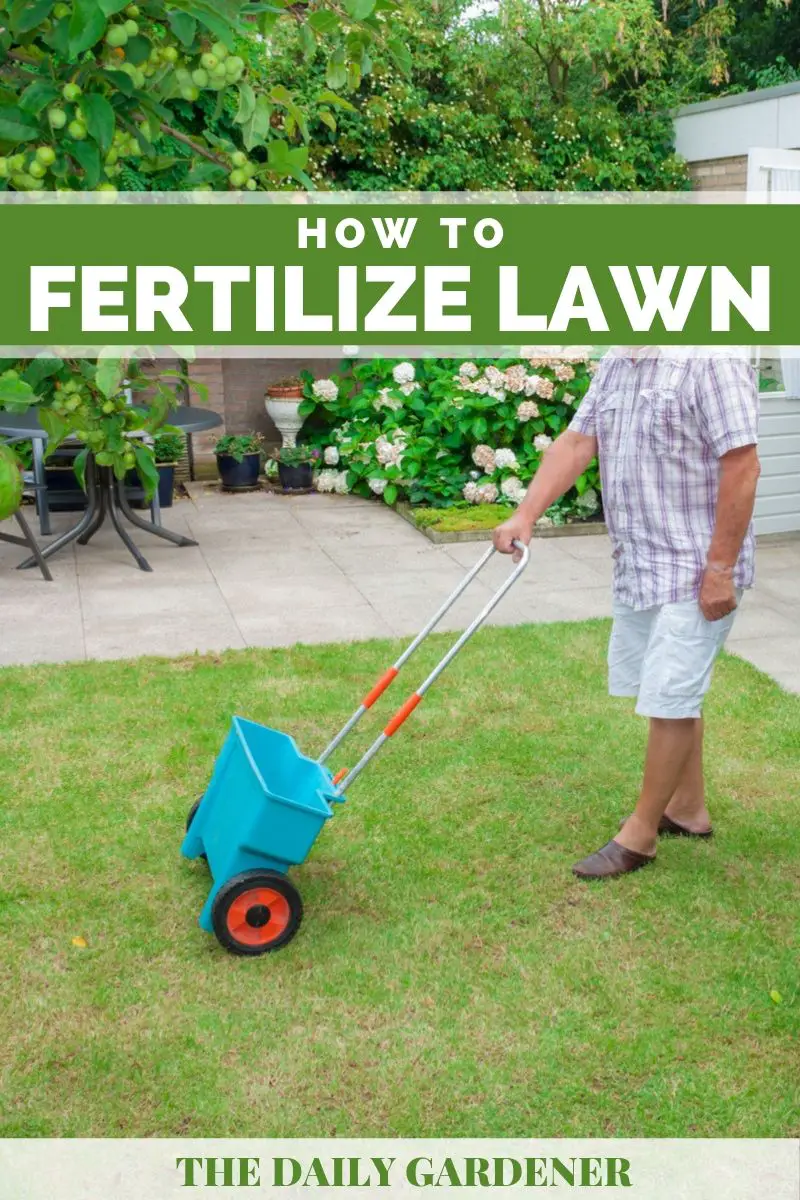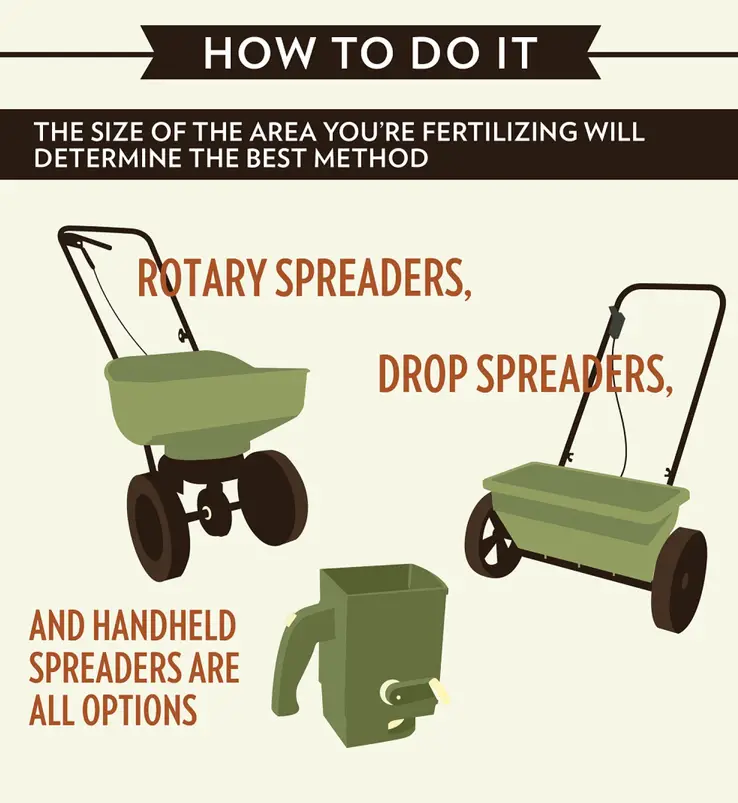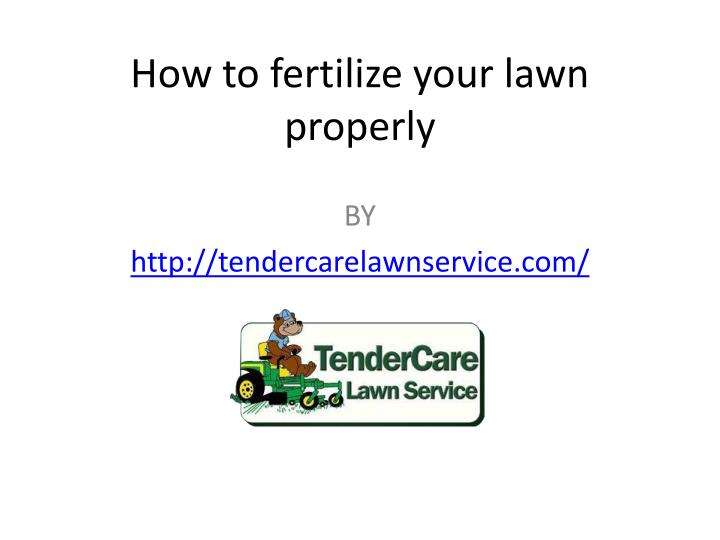S To Fertilizing Lawn
Steps To Fertilize Your Lawn Following these simple steps, along with the helpful Do’s and Don’ts, can help make your lawn greener and stronger. Be sure to check the label or contact your local Cooperative Extension for the best application timings and amounts.
For most lawn fertilizers, you should see results in 7-10 days. Fertilizers with 100% slow-release nitrogen may take longer.
DON’Ts
How To Apply Fertilizer To Your Lawn
Lawn fertilizers are sold in either liquid or granulated form.
This is mostly important in determining how to spread the fertilizer. With organic fertilizers, the difference comes down to what the fertilizer is comprised of. Corn grain meal based fertilizers are typically granular, while fish emulsions are liquid.
Synthetic fertilizers are available in both forms.
Speaking generally, most homeowners find granular fertilizers easier to apply.
If you want to use a liquid fertilizer, it is simpler to hire a professional service like TruGreen or a local alternative to do so.
Its more difficult to measure out and ensure even application of a liquid fertilizer. Professional services do that regularly and understand how to apply it.
Using a spreader to apply granular fertilizer is a simple process. A small broadcast spreader can be bought locally or for under $40.
Using a spreader is easy fill the hopper up on pavement, then walk the spreader across your yard.
Start with the perimeter, using an edge-guard to keep the material in your grass. Then go line by line until your yard is covered.
Spread it at a lower than recommended rate at first. This way youre sure not to add too much and damage your yard .
Make sure to sweep any granules off the pavement and into your yard. Left on pavement, they can harm the environment if allowed to wash into storm drains.
Should I Fertilize My Lawn Before Or After Mowing
Ideally, youll want to mow and rake before fertilizing so that excess lawn waste is removed, allowing the fertilizer to have an easier time reaching the soil. Aerating your soil before fertilizing can also help. When fertilizing a lawn, it is best to apply fertilizer after the lawn has been mowed so it has a few days to absorb the fertilizer.
Read Also: Killing Clover With Vinegar
How Often Should You Put Epsom Salt On Your Lawn
Some homeowners like to use Epsom salt as a natural lawn fertilizer in the spring to facilitate lush green growth. Epsom salt contains magnesium, which is key to seed germination, chlorophyll production, and improving the uptake of nitrogen, phosphorus, and sulfur.
To try this method, add 2 tablespoons to each gallon of water used on the lawn. If you have a sprinkler system, lightly sprinkle the salt directly atop the grass and then allow the system to water it into the sod.
Are There Are Alternatives To Chemical Lawn Fertilizers

There are organic alternatives to chemical lawn fertilizers but if you want to use a really sustainable approach, one way to feed a lawn is through mulching. Paul Hicks, Product Manager at STIHL , says: ‘One way to achieve a lush lawn is through regular fertilizing, however this doesnt just mean using chemical treatments as mulching is a great natural alternative. Mulching is basically the process of cutting the grass and chopping the clippings into tiny pieces, with one pass of the mower. These clippings are then returned to the turf containing all the essential nutrients the lawn needs for healthy growth.
‘Mulching can be achieved by using a special mower that has been designed to mulch. These mowers are often not able to collect grass and instead, they have a special profile in the cutter deck and a specially designed blade.
‘However, there are some mowers out there that offer the best of both worlds and can collect the clippings in a grass box but can also be converted into a mulching mower with an accessory kit.
Don’t Miss: Rgs Biostimulant
Which Are The Best Lawn Fertilizers To Use
You can buy lawn fertilizer in granule or liquid form. There is no ‘best fertilizer’ as such, because the one you use will need to suit these variables below.
You need a fertilizer that suits the season so one that is suited for spring or one suited to fall. ‘In spring, the fertilizer will be higher in nitrogen to kickstart your lawns growth and color and it will also tackle the oncoming warmer weather. In the summer, the fertilizer will help retain the healthy green color, nourish your lawn and avoid scorching. And then in the autumn, which is perhaps the most important time of year for a lawn feed, should be higher in potassium and phosphate to produce healthy roots and help the lawn get in good shape to cope with winter. It will also keep away various pests that can harm your turf,’ says David Truby, Managing Director of lawncare experts, Greensleeves .
You need to avoid cheap fertilizers which can often contain too much nitrogen . These cheaper feeds may work in the short-term but won’t over a long period. ‘Use a fertilizer that contains the right ingredients for your lawns needs. For example, a high nitrogen content will encourage growth and greenness, whereas a high phosphorus content will improve root growth,’ says Fiona Jenkins, gardening expert at MyJobQuote .
You need to buy a fertilizer that suits the type of lawn and soil type you have.
Organic or chemical? There are organic alternatives to chemical lawn fertilizers .
Clean The Spreader And Water The Lawn
- After youve covered the lawn, check for any fertilizer that may have scattered onto your driveway, sidewalk or walkway. Use a broom and dust pan to clean these areas. Fertilizers contain minerals that can stain concrete. You can sprinkle any small amounts of leftover fertilizer back onto the lawn after you have scooped it up.
- Put the lawn spreader on the lawn and rinse it off with a garden hose. This allows you to make use of fertilizer thats stuck in and around the spreader. Clean the hopper plate and wheels thoroughly. Allow the lawn spreader to dry before storing it.
- Water the lawn thoroughly with a lawn sprinkler. This will mix the nutrients from the fertilizer into the soil.
You May Like: Adios Weed Killer Lowes
What Happens If I Over
Along with fertilize burn, over-fertilizing can cause damage to your turfs root structure, as well. Some fertilizers contain high levels of nitrogen, which if absorbed in large amounts can become harmful. What mainly causes the dreaded burn, however, is an abundant accumulation of soluble salts.
Lawn Fertilizer Schedule For Cool
Early spring: When the grass greens up after winter, usually late March or early April depending on the year and where you live
Early fall: The beginning of the second active growth season, usually early September
Late fall: At least 6 weeks before the first expected frost in your area, usually late October or early November depending on the year and where you live
Don’t Miss: How To Thicken A Thin Lawn
Tips And Tricks For Fertilizing Cool
Cool-season grasses are usually found in northern areas of the United States. They grow best when temperatures are between 60 and 70 degrees Fahrenheit. Types of cool-season grass include:
- Perennial ryegrass: Perennial ryegrass has pointed blades with visible veins.
- Kentucky bluegrass: Kentucky bluegrass is dark green, soft and V-shaped with pointed blades.
- Tall fescue: Tall fescue grass is dark green and course with pointed blades and visible veins.
Fertilize cool-season grass in the fall, after the intense heat of summer and before cold weather sets in. You may choose to use a winterizer fertilizer, which is specifically formulated to protect grass during the winter months.
Fertilize again in early spring before hot summer weather arrives. If your lawn is green and growing actively during the summer, you can continue to fertilize it throughout the summer months. However, if your grass tends to turn brown in summer, temporarily stop feeding it until it starts to grow and turn green again, likely in early fall.
Cool Season Vs Warm Season Grass
Warm season grasses thrive in warm-weather regions, such as the southern United States. It’s best to feed warm season grasses in warm weather as they grow most actively during the heat of summer.
Popular warm season grasses include:
- St. Augustine: Broad dark green blades with a rounded tip
- Zoysia: Prickly, stiff and narrow blades form a carpet-like lawn
- Centipede: Pointed blades with a notch that grows to be dense and soft
Cool season grasses do best where there are extreme temperature fluctuations, such as those in the North, Northeast and Pacific Northwest.
In the North, where cool-season grass types are popular, lawns need to be fed four times a year with each feeding six to eight weeks apart. If your lawn is still green and actively growing in the summer, you can continue to feed it throughout the summer months at the same rate. However, if your grass turns brown during summer heat and drought, temporarily stop feeding until it starts to grow and turn green again in the early fall.
Popular cool seaon grasses include:
- Kentucky Bluegrass: V-shaped with pointed blades, dark green and soft
- Perennial Ryegrass: Pointed blades with visible veins
- Tall Fescue: Dark green, coarse, wide pointed blades with visible veins
Make your lawn fertilizer project easier, with the right products and tools. Find what you need. Use The Home Depot Mobile App to locate products and check inventory. We’ll take you to the exact aisle and bay.
Shop this Project
Don’t Miss: Killing Wild Violets In Lawn
When To Use Compost
Compost does more than feed grass it also builds and feeds soil. Compost contains microorganisms, micronutrients and organic matter items that nourish soil and foster a healthy underground environment in your lawn. When should you use compost? Spread a thin layer over lawns in early spring to fuel strong growth. Any time you plan to aerate, spread compost after aerating to improve soil and give roots a boost. It’s also a good idea to apply compost before overseeding thin turf. Add compost to a lawn by the shovelful in several places.
Create A Lawn Fertilizer Schedule

Making a schedule helps keep you on track to fertilize at the right times. Incorporate it as part of your overall lawn care plan, which should also include watering, weed maintenance, how low or high to mow the grass. Keep a plan for the entire year and break it down by season. Its also important to review and adjust your lawn fertilizer schedule yearly, as some general rules will work for your specific lawn, and others may not.
Recommended Reading: Home Depot Hydroseed
Fill And Prepare A Lawn Spreader
- Next, check the instructions on your fertilizer bag for the recommended setting to use on your lawn spreader. This determines the amount of fertilizer that will be distributed. The higher the setting, the larger the hole size in the hopper and thus, the more fertilizer spread on the lawn. Adjust the setting on the spreader accordingly.
- Before you fill the spreader with fertilizer, make sure the hopper hole is closed. Fill the hopper on a hard surface, such as a driveway or sidewalk. This will prevent a potential spill from damaging or saturating a spot on your lawn.
- Be careful not to overfill the hopper or the lawn spreader may become hard to maneuver. Your lawn spreader may come with an edging feature to help you avoid dispensing fertilizer onto your driveway, sidewalk or walkway. If so, turn it on before you begin fertilizing that area. Follow all other instructions provided by your manufacturer for operating your lawn spreader.
Choosing A Lawn Care Company
If you don’t want to do it yourself, there are many companies that maintain lawns and control pests. Some may include services marketed as organic or pesticide-free.
To choose the option best for you:
- Find out what programs and prices companies in your area offer, and what results you can expect.
- Avoid lawn care programs that apply pesticides even when pests are not present.
- If pesticides are used, make sure that they are used as part of an Integrated Pest Management program.
Don’t Miss: How Much Does It Cost To Have Your Yard Mowed
After Your First Lawn Fertilizer Application
So now you know about the first treatment, but are wondering how often to fertilize lawn areas throughout the rest of the year?
After your first application, you want to apply another round of fertilizer 6 to 8 weeks later and repeat that two more times with 6 to 8 weeks in between.
Try to schedule your applications so you apply ahead of the hottest part of summer to give your lawn the necessary boost.
For an established lawn, youll fertilize 4 times each season, though that is based on some important assumptions. If your grass is damaged and youre growing it fresh, your lawn will require more treatments until its established.
This is also true if your lawn has a species of grass that isnt native to your climate, like in areas that are more hostile to grasses. Alternatively, the opposite is also true. Fertilizing regularly is most necessary when trying to keep alive grasses that arent native to your area.
Its very likely you can get away with only fertilizing 1 to 2 times per year if the grass in your lawn is native. A healthy lawn can get by with fertilizing in the spring, and maybe again In the fall to keep it strong through the off-season.
Using A Broadcast Or Rotary Spreader
A broadcast or rotary spreader works well when you’re fertilizing larger lawn areas. Before filling the hopper, make sure it’s closed. It’s a good idea to fill it on a tarp, so you can easily gather any spilled fertilizer. Apply fertilizer around the perimeter of the lawn first, and then start to move back and forth across turf in an orderly pattern. Overlap application strips slightly to ensure that you cover the whole lawn evenly with fertilizer.
Also Check: Homemade Rabbit Repellent For Lawn
When To Fertilize Your Lawn: Timing And Frequency
Choosing the correct time and schedule to fertilize your lawn is essential to a beautiful yard. Here are the best tips on how to get your lawn in its best shape this year.
Lawn fertilizer is like food for your grass, providing it with the nutrients it needs to grow and maintain its healthy, green glow. Each fertilizer uses a unique combination of nutrients, though most include nitrogen, phosphorus, and potassium. These ingredients create a vibrant lawn that resists weeds like crabgrass while creating an optimal environment for good microorganisms and worms.
While its important to fertilize your lawn, throwing down these nutrients at any time of the season wont help your grass reach its full potential. Instead, its important to consider your grass type and the environment you live in before deciding on a time to fertilize. Read on to learn more about the best time to fertilize your lawn, how often you should do it, and the factors that impact growth.
When To Put Fertilizer On Lawns
All lawns need fertilizer in early spring when the grass begins to green up. Your fertilization schedule for the rest of the season depends on the type of grass in your lawn, the type of fertilizer you use, and your climate. Most lawn seed is a mixture of several different types of grasses, and both spring and fall fertilization are appropriate.
The label on a bag of lawn fertilizer will recommend a schedule based on the type of fertilizer it contains. The label is your best guide to how often to apply the product and how much to use. As long as you dont overdo it and avoid fertilizing in the hottest part of summer, your lawn should thrive.
Also Check: Teenager Lawn Mowing Business
Apply Your Fertilizer When Grass Is Growing
No matter how frequently you fertilize your lawn, the rule of thumb you should follow is that you should apply fertilizer while your grass is growing the fastest.
Over applying fertilizer runs a big risk to your yard:
- Its bad for the environment, since runoff pollutes local streams.
- It runs the risk of burning your grass, which is when you sap grass of natural nutrients causing it to brown.
- Lastly, youre wasting money by buying too much fertilizer.
What Is The Best Lawn Fertilizer For Early Spring

A longer-lasting fertilizer is typically healthier for your lawn in the spring, since it requires fewer applications. Nitrogen is the most important nutrient, but keep in mind that there are fast-release and controlled-release nitrogen sources. To check what the fertilizer contains, just look in the guaranteed analysis section on the back of the bag. Key terms to look for include controlled-release, slow-release, slowly-available, or water-insoluble nitrogen. Some specific types that may be listed include ureaform, sulfur-coated urea, polymer-coated urea, and IBDU . Several organic nitrogen sources are controlled-release if you prefer a more natural, less artificial choice. Most quality lawn fertilizers offer a balance of fast and controlled release sources to offer a fertilizer that will provide some quick color and some long-lasting nitrogen.
You May Like: Old Lowes Riding Lawn Mowers
